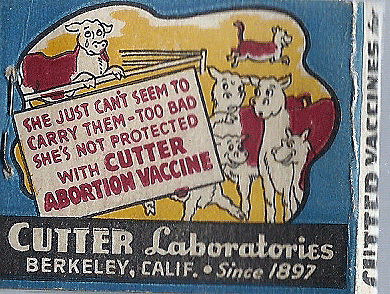[Author's note: This lengthy investigation into the history of Bayer's unethical practices was prompted by the proposed expansion of its plant in Berkeley in the 90s. I'm republishing it now due to the proposed sale of Monsanto to Bayer AG. In addition to examining Bayer's major role during the Nazi period, the article looks at other human rights and environmental violations by the company"...jenny miller.]
In all the local media reports of the need for haste by the City of Berkeley to finalize its negotiations with Miles Cutter Laboratories for a 30 year development agreement, very little has been said about the parent organization, the giant German pharmaceutical company, Bayer AG. Bayer (the phonetic spelling of the German pronunciation is Buy-er) reported worldwide sales of $23.3 billion in 1989. Aside from their famous trademark name for aspirin, Bayer is probably best known as the "inventor" of heroin, which they originally promoted as a cough suppressant for children, and the development of methadone, which they called Dolophine after Adolf Hitler. Not many people are aware, however, of Bayer's complicity in World War II in the sale of Zyclon B gas, used to murder 12,000,000 concentration camp inmates (including 6,000,000 Jews), or of Bayer's use of camp inmates to conduct lethal medical "experiments."
Although Miles Cutter is frequently described as a homegrown Berkeley company, "located in Berkeley since 1903," actually Bayer acquired the Indiana-based Miles corporation in 1978, at which time it was merged with Bayer's Cutter Laboratories in Berkeley. The headquarters of Miles Cutter is still located in Elkhart, Indiana. According to news accounts at the time of the acquisition, Bayer was eager to get back into the American market, since almost all of its subsidiaries were confiscated during World War II. Even the Bayer aspirin trademark was relinquished to another company and Bayer never regained the rights to it in the U.S.
However, to anyone who has attended any of the (very few) public discussions held by the Berkeley City Council regarding the proposed expansion, it is clear that real control of the company lies in Germany. Miles Cutter is a wholly-owned subsidiary of Bayer AG, and the company stock is not traded on an American exchange. Who actually runs Miles Cutter is significant, since much of the opposition to the company is based on Bayer's history of involvement with right wing regimes, their long record of participation in chemical warfare, their dubious history of falsifying research for products they're promoting, their extensive use of animals for painful research, and the reported strong opposition to Bayer by environmental groups in Germany and elsewhere.
Hermann Stenger, the chair of Bayer AG, complains in a 1991 issue of Financial Times that developments in genetic engineering have "run into well-organized opposition from 'green citizen groups'," that has led to a virtual legislative ban on new processes which use biotechnology. This, he says, despite the company's attempt to break down people's fears by holding Hello Neighbor! evenings, complete with entertainment to draw in the crowds. As a result, Stenger foresees "more biotechnology research being driven away from Germany to the U.S." because "Americans are more pragmatic about these issues." Indeed, according to a union representative, testifying at a Berkeley Planning Commission hearing, "Miles and Bayer decided that this facility was going to become the worldwide center of their biotechnology."
Bayer And Berkeley
The Berkeley City Council has been more than receptive to Bayer's plans, and has voted to speed up the usual timelines for the citizen review process, so much so that many believe the City is in violation of the California Environmental Quality Act (CEQA), which has established timelines for review of environmental impacts. The Council held only one hearing on the development on December 3, after most of the negotiations with Miles had been completed. Prior to the Council hearing, there had been a number of hearings before boards and commissions, which had been attended only sporadically by Council members. One week after their only hearing, the council voted unanimously to adopt the development agreement.
The City Council clearly feared losing one of Berkeley's largest employers, and a significant source of taxes (Miles paid 1.4 percent of the City's business tax in 1990), in the event that Miles carried out its threat to pull out of Berkeley entirely if the development was not approved by the December deadline. That and the lure of new jobs, increased tax revenues, and hundreds of thousands of dollars in donations to a variety of programs that will accompany the development, made acceptance of the agreement irresistible to city officials.
Neighborhood residents and environmentalists have expressed alarm about a number of issues relating to the plan for the giant Miles installation, which would cover three city blocks and rise to a height of 80 feet. For one thing, the company is disposing of small amounts of radioactive waste directly into Berkeley's sewer system. Of even greater concern, is the $1.7 million contract Miles has with the Defense Department to make 2.6 million doses of bubonic plague vaccine every year. The production of this vaccine was kept a secret from the local community until the information was leaked last year by an employee, after several workers barely escaped contamination from the plague bacilli. Miles Cutter had $9.7 million in military contracts in 1987-88, according to the Defense Department's list of Prime Contract Awards, but they have not disclosed the nature of their other contracts.
Although Cutter has been manufacturing the plague vaccine since 1944, it had not occurred to the company to plan emergency response measures in the event of an earthquake or other disaster. This omission from the EIR is particularly of concern since the site is located in some areas on saturated sand and gravel, and has all the conditions necessary for liquefaction in the event of a major quake. The EIR also notes that there is no known effective treatment for some of the viruses being used by Miles Cutter, but the company declines to stop using them, on the grounds that to do so is not "practical."
Almost no one in Berkeley, with the exception of neighborhood activists like Laurie Bright, has questioned what exactly the Defense Dept. is doing with 2.6 million doses of plague vaccine every year. In an attempt to find an answer to that question, I read through the voluminous file at Oakland's Data Center on biological and chemical warfare. Although Miles claims that the vaccine is for defensive purposes, many biologists, such as MIT's Jonathan King, believe that "there is no feasible defense against biological attack." He says, "Vaccination can't work because the variety of attack agents is too large," and further, that "offensive and defensive research is indistinguishable. To make a vaccine, you must first make the pathogen the vaccine will defend against. Further blurring offense and defense is the fact that the first step in launching a biological attack would be to inoculate one's own troops against the agent thus the presence of a vaccine in a war zone would amount to an offensive threat." Reading through the final EIR, I found a news clipping which mentions that "Federal inspectors from Rockville. Maryland, did a routine inspection of Cutter in December on the assumption that plague vaccine made in Berkeley would be used in the Gulf War."
According to Dr. Barbara Rosenthal of Sloan- Kettering Cancer Center, the clock on the Biological Weapons Convention, which banned the development or stockpiling of biological weapons, runs out in 1991. Until President Nixon renounced the use of chemical or biological warfare in 1969, and the U.S. signed the Weapons Convention in 1972, the biggest center for the development of biological warfare agents (including bubonic plague) was Ft. Derrick, Maryland. However, in 1989, a San Francisco Examiner article reassuringly quotes Col. David Hudson, currently the commander of Ft. Detrick: "Read my lips - we have no biological weapons. We develop vaccines, oxides, drugs, and antitoxins."
Under the Reagan administration, funding for biological weapons grew by leaps and bounds, increasing from $15 million in 1981 to $90 million in 1986. Some of this interest may have been attributable to reported evidence that the Soviet Union was engaged in biological warfare research. According to a Defense Dept. report, in 1979 there was an accidental release of anthrax spores from the Sverdolvsk Biological Warfare Facility. The same report indicated that initial disinfection and decontamination procedures were largely ineffective, and hundreds of Soviet citizens in the surrounding area died as a result of anthrax inhalation. The incident was described by Dr. Barry Erlick, a biological weapons analyst for the U.S. Army, speaking before a Senate Committee, as a "biological Chernobyl."
(Note: You can view every article as one long page if you sign up as an Advocate Member, or higher).








